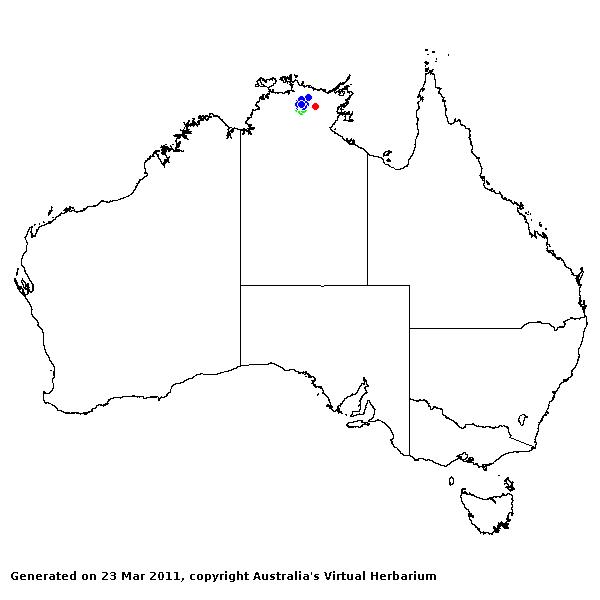Symplectrodia Nuytsia 5: 273(1985).
Derivation:.
From the Greek sym- (together or united), plekton (a spur) and
odous (tooth), contrasting an entire basal lemma with 3-toothed or 3-lobed
lemmas in the related genus Triodia.
Taxonomic
revisions, nomenclatural references:. M.Lazarides, Nuytsia 5: 273–276 (1985).
Key references
(keys and floras):. B.K.Simon, Key to Australian Grasses 167 (1993);
D.Sharp and B.K.Simon, AusGrass (2002); K.Mallet (ed.), Flora of
Australia 44B: Poaceae 3: 256–259 (2005).
W.D.Clayton &
S.A.Renvoize, Genera Graminum (1986), genus (310).
Native, endemic. 2
species. NT.
Habit.
Perennial (robust or slender), tufted (and rhizomatous). Leaf blades narrow,
hard, woody, needle-like. Ligule a fringe of hairs.
Inflorescence.
Inflorescence paniculate, an open panicle with branches ending in single
spikelets, open.
Spikelets.
Spikelets subterete, solitary, long pedicelled; with naked rachilla extension.
Fertile spikelets subterete, disarticulating above glumes, with distinctly
elongated rachilla internodes between florets (the internode above the fertile
floret up to 5 mm long and adnate to the palea, and the upper internodes also
elongated at maturity, with the sterile florete ultimately disarticulating
individually).
Glumes. Glumes
unequal, shorter than spikelet to about equal to spikelet, long relative to
adjacent lemmas, hairless, usually glabrous, pointed, awned to awnless (often
aristulate), non-keeled (rounded or flattened dorsally), similar
(cartilaginous, lanceolate-elliptic, acuminate). Lower glume 1–5 nerved. Upper
glume 3–7 nerved.
Florets.
Fertile florets 1. Lemmas similar in texture to glumes (cartilaginous), entire
at apex, pointed, awned, 3 nerved. Awns 1, apical, non-geniculate, hairless,
much shorter than body of lemma to about as long as body of lemma. Palea
relatively long, entire (acute), hardened and adnate to the rachilla below, 2
nerved, 2 keeled. Distal incomplete florets 2–5, specialised and modified
(empty, cartilaginous, 3-lobed, 3-nerved, unequally 3-awned, finally becoming
distant and prominently exserted by elongation of the internodes). Callus
pointed (curved or oblique). Lodicules 2. Stamens 3. Stigmas 2. Grain small to
medium sized (4–4.5 mm long), ellipsoid, compressed dorsiventrally. Hilum short.
Embryo large.
Kranz Anatomy.
C4.
Habitat.
Xerophytic. Species of open habitats.
Classification.
Chloridoideae; Triodieae.
Notes. An
outstanding problem in the Triodieae has been a marked inconsistency between
inflorescence and anatomical chararacters. Cladistic analysis, based on
molecular data, shows there to be greater reliance for phylogenetic grouping
based whether the leaf anatomy is 'hard' or 'soft'. On this basis Symplectrodia
is related to Triodia plectrachnoides and T. spicata (Mant et
al., 2000).
Types Species. S.
lanosa Lazarides.
Biogeographic
Element. Clifford & Simon 1981, Simon & Jacobs 1990: Endemic.


